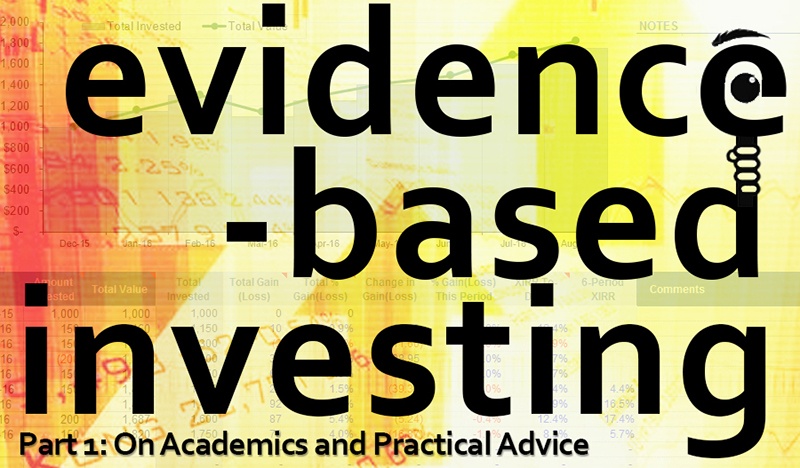
A Two-Course Take on Evidence-Based Investing Part 1: On Academics and Practical Advice
There’s little we love more than a spot-on analogy to make simple sense of investment theory – like our recent “3 Things” about how the near-term market often behaves like an unruly dog on a short leash (from “A Wealth of Common Sense” blogger Ben Carlson).
That said, while informational “snacks” are nice, sometimes a more complete meal is called for. If you’ve been craving an enhanced understanding of some of the more elegant qualities of evidence-based investing, these next couple of posts are for you.
Here, we serve up some bite-sized, but meaty excerpts from part one of an in-depth interview between The Evidence-Based Investor journalist Robin Powell and Dimensional Fund Advisors Co-CEO Gerard O’Reilly, PhD. Many thanks to Powell for agreeing to share his work with us; if our excerpts appeal, we encourage you to read the interview in its entirety – part 1 and part 2.
On academic vs. “real world” investing
“Academics come with models of the world, and those models are usually incomplete. But you gain insights about the real world from those models … so that you can understand the real world better. But that’s the beauty of it. Academics simplify the world just enough so that it’s real enough to be interesting, but understandable enough that you learn something.”
On “the greatest academics in finance”
“[Kenneth] French and [Nobel laureate Eugene] Fama’s work has helped us tremendously in using real-time security prices to say which assets have higher expected returns and which have lower expected returns. Other academics we’ve worked with are Robert Merton and Myron Scholes, both of whom have also won a Nobel Prize. … The work that they have done has really led to some big innovations in the field of practical investing.”
On withstanding the tests of time
“[S]hould you use a new [investment] model every year? Well, there are some things that stay the same, and some things that change. So Dimensional changes where we need to change, and where we don’t need to, we don’t. … [T]he underlying principle of the Three- and Five-Factor Model has been around for hundreds of years and will be around for hundreds of years.”
On incorporating new insights
“We think it’s very unlikely that every stock in the world will have the same expected return at some point in the future. Unless that happens, you’re always going to have size, value and profitability premiums. But what changes is how you go about identifying which stocks have low relative prices, and how you go about identifying which have high expected cash flows. Those things evolve as accounting practices evolve, as data evolves, and as you get better and better data.”
On why we invest to begin with
“What do investors do? Investors save, so they forgo consumption today, to grow their wealth, in excess of inflation, so they can consume more tomorrow. … If you can increase the expected return of a portfolio, there are two things you can do with that. You can lower the amount that they have to save today, to afford a similar level of consumption in the future. Or you can have them afford more in the future, so they can live an even better life in the future, from making sacrifices today.”
On pursuing higher expected returns
“When it comes to increasing expected returns, you want to do so in a very careful way. … You really have to examine what each new variable brings to the table. Does it improve your understanding of expected returns and, in particular, differences in expected returns across stocks? … If you’re into 30 or 40 or 50 factors, they’re all interacting with each other, and it’s not clear what you’re getting in that sort of portfolio. As few as possible to describe the world well is Dimensional’s preferred position.”
Making sense so far? Come back next week, for another heaping helping of the same.
 SAGE Serendipity: Discover.com published excerpts of writer Ceri Levy and “gonzo” artist Ralph Steadman’s book on near extinct animals, Critical Critters. “Levy asked Steadman to draw one particular endangered bird for an art exhibition. He agreed. But Steadman couldn’t stop at just one; he’s now drawn hundreds of endangered species. The pair have published three books together, including their latest, Critical Critters.” Check out the article Where the Wild Things Aren’t to see some of the amazing drawings of the beautiful creatures we could lose.
SAGE Serendipity: Discover.com published excerpts of writer Ceri Levy and “gonzo” artist Ralph Steadman’s book on near extinct animals, Critical Critters. “Levy asked Steadman to draw one particular endangered bird for an art exhibition. He agreed. But Steadman couldn’t stop at just one; he’s now drawn hundreds of endangered species. The pair have published three books together, including their latest, Critical Critters.” Check out the article Where the Wild Things Aren’t to see some of the amazing drawings of the beautiful creatures we could lose.
 Secure Document Sharing
Secure Document Sharing


